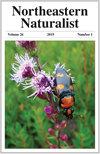化学处理对东部铁杉林分鸣禽数量的影响
IF 0.5
4区 环境科学与生态学
Q4 BIODIVERSITY CONSERVATION
引用次数: 0
摘要
摘要化学处理被用来保护加拿大小蠊(东部大蠊)免受小蠊的侵害,但人们对鸟类群落的反应知之甚少。2009年和2018年,我们在肯塔基州阿巴拉契亚山脉的65个地点(37个处理地点)测试了吡虫啉土壤浸剂对铁杉的功效及其对鸟类指示物种的影响。无论化学处理如何,铁杉的死亡率都增加了11%。铁杉在处理部位具有较高的活力,但铁杉衰退指数因处理而异。6种指示鸟类中没有一种对化学处理表现出显著的种群反应。Setophaga virens(黑喉绿莺)在接受治疗和未接受治疗的地区之间呈下降趋势,而Contopus virens(Eastern Wood Pewee)在几年之间呈上升趋势。处理对个体铁杉产生了积极影响,但这并没有影响到鸟类物种。在鸟类做出反应之前,大麻的健康状况可能需要下降到某个阈值以下。本文章由计算机程序翻译,如有差异,请以英文原文为准。
Abundance of Songbirds in Eastern Hemlock Stands Following Chemical Treatments for Hemlock Woolly Adelgid
Abstract Chemical treatments are used to protect Tsuga canadensis (Eastern Hemlock) from Adelges tsugae (Hemlock Woolly Adelgid), yet little is known about how avian communities respond. We tested the efficacy of imidacloprid soil drenches on hemlocks and its impact on avian indicator species in the Appalachian Mountains of Kentucky at 65 sites (37 treated) in 2009 and 2018. Percent dead hemlock increased 11%, regardless of chemical treatment. Hemlock had higher vigor in treated sites, but a hemlock-decline index did not differ by treatment. None of 6 indicator bird species showed a significant population response to chemical treatments. Setophaga virens (Black-throated Green Warbler) declined between years across treated and untreated sites, whereas Contopus virens (Eastern Wood-Pewee) increased between years. Treatments positively affected individual hemlocks, but this did not carry over to influence avian species. Hemlock health may need to decline below some threshold before avian species respond.
求助全文
通过发布文献求助,成功后即可免费获取论文全文。
去求助
来源期刊

Northeastern Naturalist
环境科学-生态学
CiteScore
1.10
自引率
0.00%
发文量
42
审稿时长
18-36 weeks
期刊介绍:
The Northeastern Naturalist covers all aspects of the natural history sciences of terrestrial, freshwater, and marine organisms and the environments of the northeastern portion of North America, roughly bounded from Virginia to Missouri, north to Minnesota and Nunavut, east to Newfoundland, and south back to Virginia. Manuscripts based on field studies outside of this region that provide information on species within this region may be considered at the Editor’s discretion.
The journal welcomes manuscripts based on observations and research focused on the biology of terrestrial, freshwater, and marine organisms and communities as it relates to their life histories and their function within, use of, and adaptation to the environment and the habitats in which they are found, as well as on the ecology and conservation of species and habitats. Such studies may encompass measurements, surveys, and/or experiments in the field, under lab conditions, or utilizing museum and herbarium specimens. Subject areas include, but are not limited to, anatomy, behavior, biogeography, biology, conservation, evolution, ecology, genetics, parasitology, physiology, population biology, and taxonomy. Strict lab, modeling, and simulation studies on natural history aspects of the region, without any field component, will be considered for publication as long as the research has direct and clear significance to field naturalists and the manuscript discusses these implications.
 求助内容:
求助内容: 应助结果提醒方式:
应助结果提醒方式:


